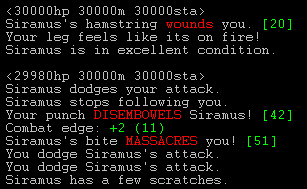- Complexity in structure, not quantity. Lusternia has hundreds of afflictions, attacks, defenses, skills, and other moving parts. The number of things you need to do before you can stand a chance in a real fight is impossibly dauntingly large, and discourages people from joining in. I would have about 1/6 as many "moving parts", but I would design them to encourage more combos and synergies, including ones that a single person, not just a team, could use. It's be more like Legos: a vast array of possibilities from a modest handful of building blocks.

- Encourage systems. I would publish trigger texts and make them regular. I'd have very few skills that masked or faked afflictions, and those would be high-power, high-cost skills, rarely used. Curing would be difficult not through obscurity but through synergies of attacks and manuevers, making it a tactical game.
- Explicit, limited teaming. I would not discourage team combat, but I would make sure size of team wasn't the trumping factor by putting limiting mechanisms on teams. Lots of skills would be designed to work within a team and synergize with others in a team, but a team would be something you'd explicitly create and join, and be limited in size to about five. I'd put mechanisms in place to make it hard and dangerous for a team to help another team, to prevent people forming "meta-teams". Might also give smaller teams a boost to help make up for the number differences.
- Much, much slower. This is the big one. Everything would happen about 1/10th as fast. Everything. It would be possible to follow the spam without tricky techniques. You'd be able to use strategy and tactics during a fight. You'd even be able to talk with each other during a fight, and that'd mean leadership, cooperation, and team structure would become far more important. It wouldn't be a competition between tactics worked out ahead of time and coded into a system; it'd be a competition between the tactical wizardry of the players involved.
Saturday, December 30, 2006
Designing a MUD combat system
Unrelated to the events in Harshlands I've been blogging about, I've been thinking about what I would do if I were designing a combat system for a MUD from the ground up, without having to worry about anything but making it cool and fun and interesting. While I like in theory how in Harshlands 95% of combat success comes from your character's skill, not yours, I also don't like how that makes combat an event to watch, not a game to play. What I'd end up with would look more like the Iron Realms model but with these major differences:
Subscribe to:
Post Comments (Atom)

 RealTime and RTC
RealTime and RTC Prism
Prism Uncreated
Uncreated Bloodweavers
Bloodweavers Foulspawner's Legacy
Foulspawner's Legacy Lusternia
Lusternia
1 comment:
I'm particularly in favor of slowing down computerized combat systems. Digital fighting appeals to me in part because the programmers can (in theory) work out a simple interface to deal with a great deal of tactical complexity. I'm always disappointed when they just make a twitch game with shiny graphics; I'm not sure what the equivalent of shiny graphics is in a MUD. :)
Post a Comment